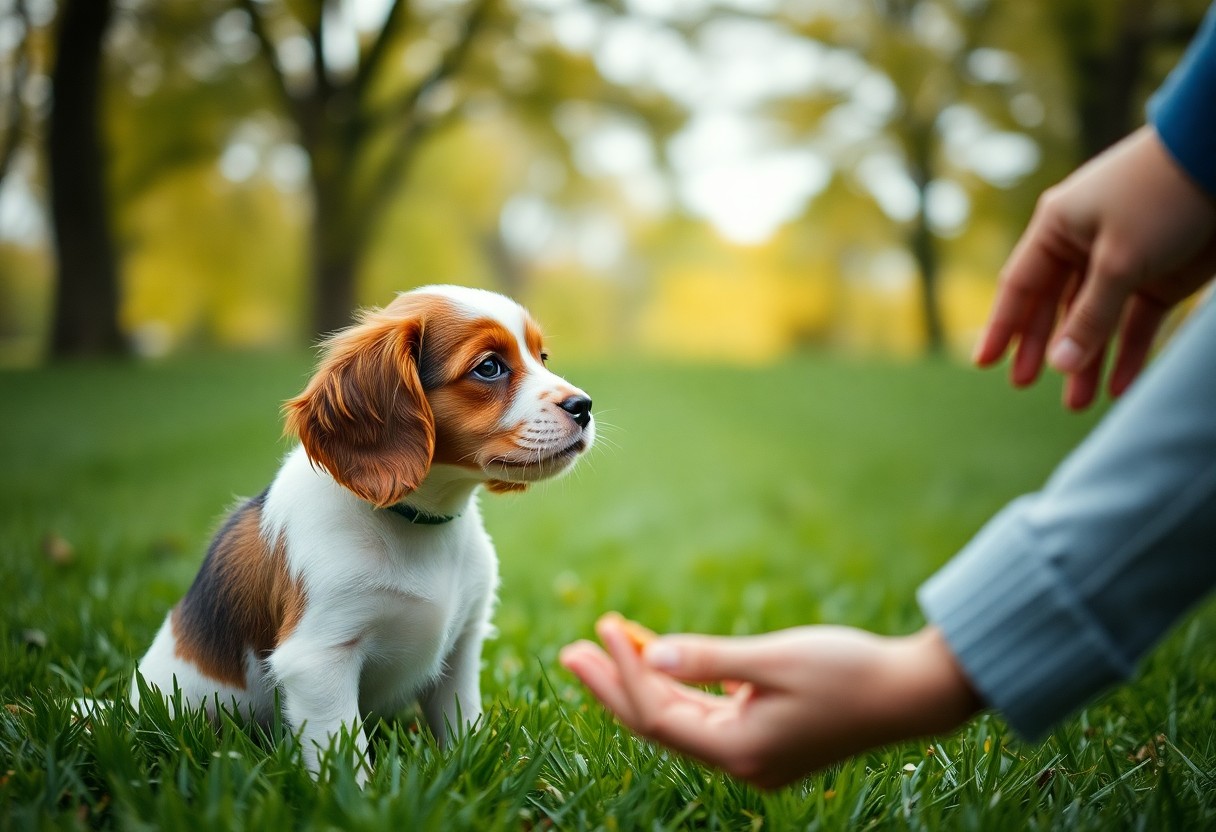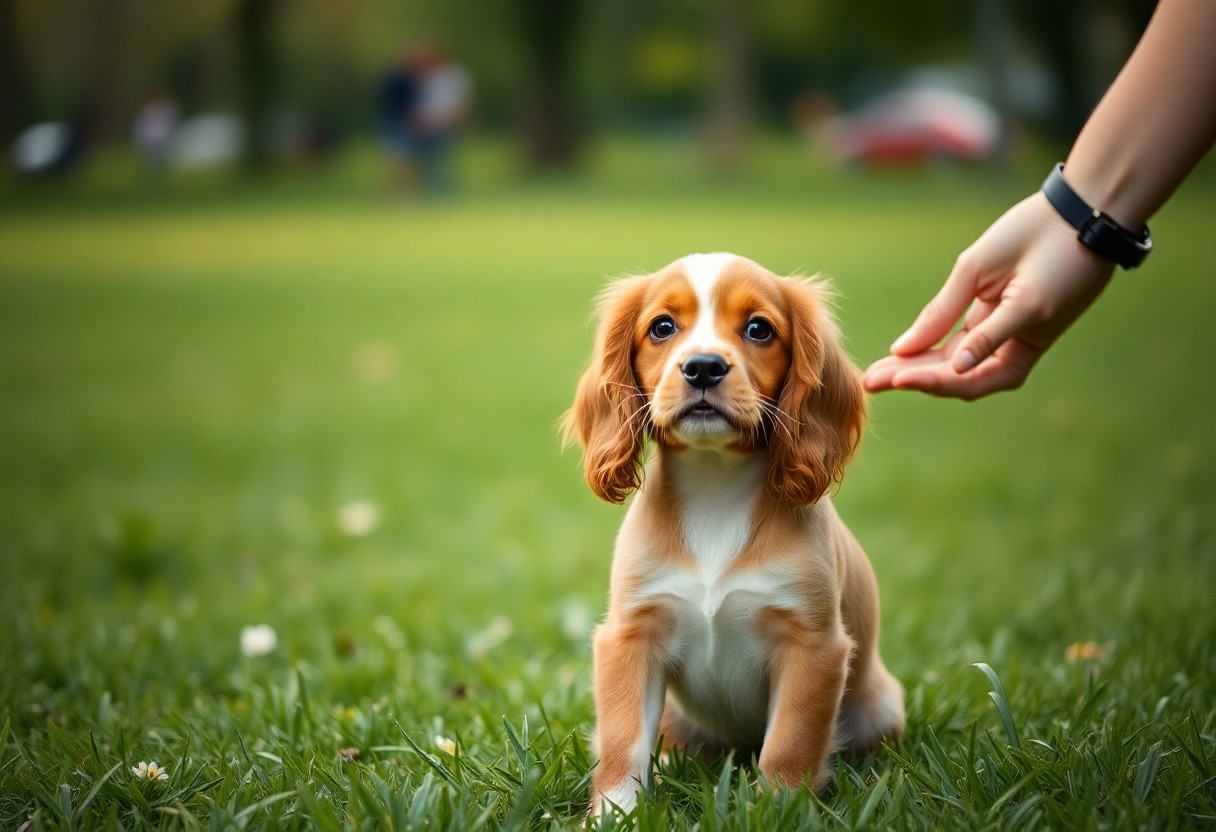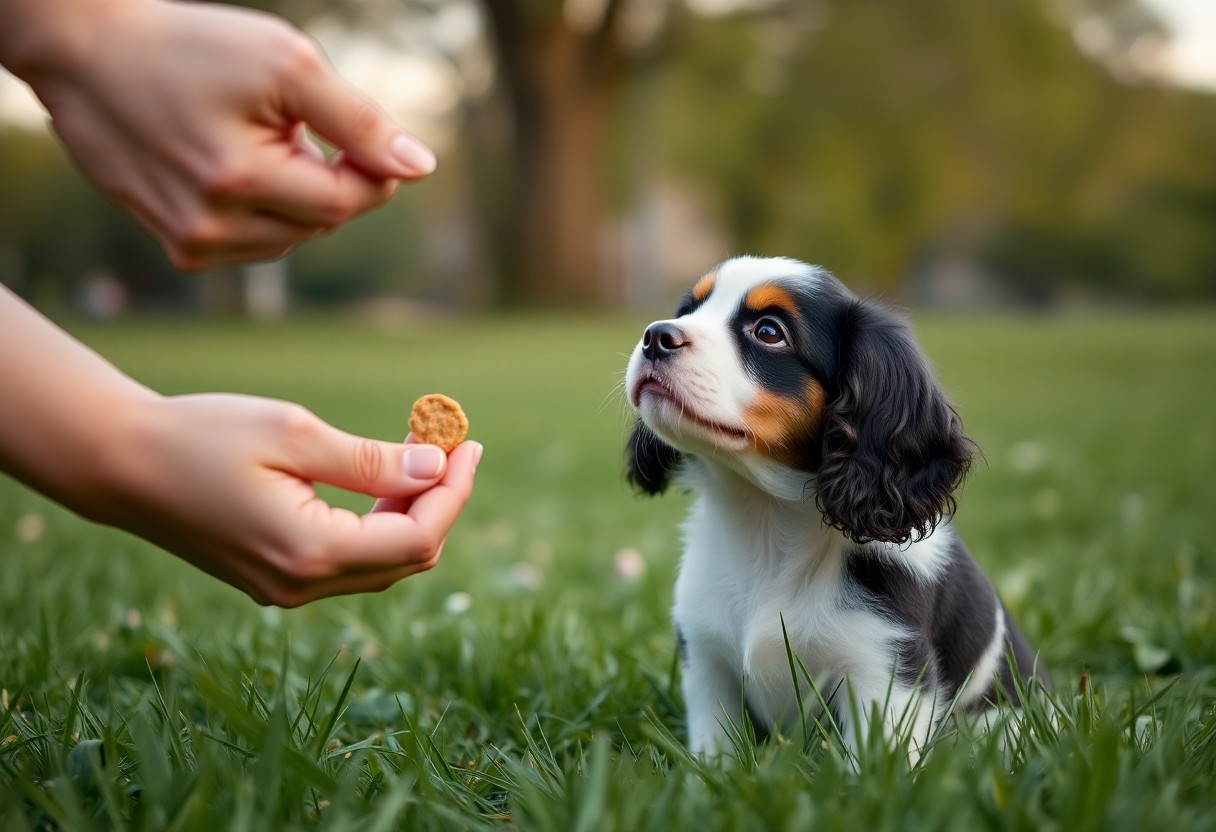This guide will help you effectively train your Spaniel puppy to come when called, ensuring their safety during outdoor adventures. By using positive reinforcement techniques and establishing a strong bond, you’ll make your training sessions enjoyable and productive. Start by selecting a reward that your puppy loves, like treats or playtime, to motivate them. Consistency is key; practice regularly in a distraction-free environment before moving to more challenging settings. With patience and dedication, you’ll develop a recall that not only keeps your puppy safe but also strengthens your relationship.
Key Takeaways:
- Begin training in a secure, distraction-free environment.
- Use a consistent verbal cue, such as “come” or “here,” paired with positive reinforcement.
- Encourage your Spaniel with treats, toys, or praise to make coming to you a rewarding experience.
- Practice the recall command frequently and gradually increase the distance you call your puppy from.
- Make the training sessions short and engaging to keep your puppy’s attention focused.
- Avoid punishment if your puppy does not respond; instead, maintain a positive and encouraging approach.
- Gradually introduce distractions and practice in various environments to ensure reliable recall in different situations.
Understanding Spaniel Behaviors
Your Spaniel puppy is a unique and spirited breed, known for their lively disposition and eagerness to please. Understanding their natural instincts and behaviors is imperative for effective training. Spaniels are bred for hunting and retrieving, which means they possess a strong prey drive and a sense of curiosity that can sometimes lead them astray. By learning about your puppy’s behavioral traits, you can better tailor your training approach to engage their attention and ensure they come when called effortlessly.
The Nature of Spaniels
For Spaniels, their friendly personality, high energy levels, and intelligence make them wonderful companions. These dogs thrive on human interaction and are responsive to training when approached in a positive manner. They adore playtime and activities that allow them to explore their environment, making it imperative for you to incorporate engaging methods and rewards in your training routines to keep their interest piqued.
Common Challenges in Training
An integral part of training your Spaniel puppy involves tackling several common challenges that may arise. Their strong prey drive can divert their attention, making them more interested in chasing squirrels or other animals than responding to your call. Additionally, their exuberance often leads to impulsive behaviors, making them less focused during training sessions. Therefore, employing consistent training techniques and understanding their motivations can significantly enhance your success.
Common challenges in training Spaniel puppies often stem from their enthusiastic nature. Their innate drive to chase and explore may lead them to prioritize distractions over your commands, which can pose safety risks. To navigate these challenges effectively, ensure you consistently use positive reinforcement to encourage good behavior while gradually building your puppy’s focus. Keeping training sessions short, engaging, and filled with high-value rewards can capture their attention and maximize the chance of success, ultimately leading to a reliable recall.
Essential Training Tools
You will need a few vital training tools to effectively teach your Spaniel puppy to come when called. Begin by using a high-quality clicker or a verbal marker to reinforce positive behavior. Treats should be enticing and small enough for your puppy to eat quickly, and a long leash can help manage their exploration while you practice this command.
Items You Need
Assuming you’re prepared to train your puppy, gather the following items: a clicker or verbal marker for positive reinforcement, some high-quality treats, a long leash for controlled freedom, and a consistent command like “come.” These tools will assist you in creating a productive training environment.
Creating a Positive Environment
One way to ensure successful training is by creating a positive and distraction-free environment. This means training in a place where your puppy won’t be overwhelmed by noises or other animals. Start indoors or in a fenced yard where you can focus on your puppy’s response to your commands.
With a calm and controlled setting, your puppy can easily learn to associate the command with rewards. Use food treats or their favorite toy whenever they respond correctly, reinforcing the behavior positively. Also, maintaining a cheerful demeanor while calling your puppy will help them feel enthusiastic about coming to you. This environment fosters trust and excitement, making it easier for your puppy to learn the command effectively.
The Basics of the Come Command
Now that you’re ready to train your Spaniel puppy, it’s necessary to understand the basics of the ‘Come’ command. This simple yet effective command forms the foundation of your dog’s recall skills, enabling your furry friend to respond promptly and confidently when called. By teaching your puppy to come to you, you enhance their safety and strengthen your bond. Start by creating a positive association with the command, making it a vital part of your training routine.
Teaching the Command
Now, to effectively teach the ‘Come’ command, begin in a controlled environment free from distractions. Use a cheerful tone and call your puppy’s name followed by the command ‘Come’. When your puppy moves toward you, reward them with praise and treats. Consistency is key; practice frequently in various locations to reinforce their understanding of the command.
Reinforcement Techniques
Little incentives can drastically improve your puppy’s response to the ‘Come’ command. Use treats, affection, or their favorite toy as rewards when they successfully come to you. The goal is to create a positive experience associated with the command, ensuring your puppy finds value in responding promptly.
This positive reinforcement can greatly accelerate your puppy’s learning process. When your Spaniel responds well to the ‘Come’ command, it’s important to provide immediate rewards, such as treats or enthusiastic praise. This connection between action and reward will encourage them to come to you in the future. Additionally, vary your rewards to keep your puppy engaged; using a mix of treats, toys, and affection will make the training sessions more enjoyable. Lastly, be patient and consistent because the more rewarding the experience, the more likely your puppy will come running when called.
Tips for Successful Training
Despite the challenges that may arise, proper training can help your Spaniel puppy become an obedient companion. Here are some tips to enhance your training experience:
- Start training in a distraction-free environment.
- Use consistent cues and commands.
- Practice frequently to reinforce learning.
- Keep training sessions short and engaging.
- Celebrate small victories with positive reinforcement.
Knowing these tips will set you on the right path for a well-trained puppy.
Consistency is Key
One of the most effective strategies you can employ is to maintain consistency in your training routine. This means using the same words, gestures, and methods every time you call your Spaniel puppy. Consistent practice helps build familiarity and reliability, making it easier for your puppy to understand what is expected of them.
Using Positive Reinforcement
Tips like offering treats or praise can significantly enhance your puppy’s response to commands. You should use positive reinforcement to encourage your Spaniel puppy whenever they come to you when called. This can include giving treats, verbal praise, or affection, which will help your puppy associate coming to you with positive experiences. Successful training also involves ensuring that the rewards are immediate so your puppy understands the behavior that earned them. This strategy not only strengthens your bond but also fosters a love for learning in your Spaniel puppy. By making learning enjoyable, you create a happy, responsive dog.
Factors Influencing Training Success
To effectively train your Spaniel puppy to come when called, several factors can influence your success. Consider the following:
- Aging of the puppy
- Consistency in training
- Positive reinforcement
- Environmental distractions
Getting your puppy to respond reliably requires understanding these influences and adapting your techniques accordingly. This holistic approach, combined with 4 Trainer-Approved Tips to Teach Your Dog To Come, will enhance your training efforts.
Age and Maturity of the Puppy
While your puppy’s age plays a significant role in training, younger puppies are often more energetic and may have shorter attention spans. As your Spaniel matures, their ability to comprehend and respond to commands typically improves, making consistency in training important during this formative phase.
Environmental Distractions
Some distractions can hinder your puppy’s ability to focus during training sessions. Limiting these distractions is vital for effective training.
For instance, common environmental distractions such as other dogs, loud noises, or stimulating scents can divert your puppy’s attention away from the training. Being aware of your surroundings and choosing calm environments will help your Spaniel concentrate more effectively on your commands. Additionally, gradually introducing your puppy to increasingly distracting environments can bolster their responsiveness to your calls, fostering a reliable recall in various situations.
Troubleshooting Common Issues
Unlike other breeds, Spaniels can sometimes exhibit stubbornness when it comes to responding to commands. This can be particularly challenging during training sessions. If you encounter issues with your puppy not responding or showing reluctance, it’s important to identify the root cause and adjust your approach to ensure effective communication and positive reinforcement.
Ignoring the Command
If your Spaniel puppy consistently ignores your command to come, it may be due to distractions, lack of motivation, or not understanding the cue. You should evaluate your training environment and consider practicing in quieter spaces. Reinforcing positive associations with the command through treats and praise can also encourage better responses.
Fear and Anxiety in Puppies
On occasion, your puppy may display fear or anxiety that inhibits their ability to come when called. Factors like loud noises, unfamiliar environments, or negative experiences can trigger this response. Identifying what causes your puppy’s fear is vital for mitigating these reactions.
Anxiety in puppies can manifest in various ways, such as trembling, hiding, or refusing to engage. It’s important to provide your puppy with a safe and comforting environment while gradually exposing them to new stimuli at their own pace. Practice calling your puppy in low-stress situations, using positive reinforcement to build their confidence. Over time, this will help them feel more secure and willing to respond to your commands, leading to a more successful training outcome.
Final Words
Conclusively, mastering the recall command with your Spaniel puppy is an important skill that enhances their safety and strengthens your bond. By implementing consistent training techniques, positive reinforcement, and gradually increasing distractions, you can ensure your puppy responds promptly when called. Stay patient and set realistic expectations throughout the training process. For more detailed guidance, check out this resource on How Do I Train My Dog To Come When Called? to further enhance your training strategy.
FAQ
Q: What is the best age to start training a Spaniel puppy to come when called?
A: It is ideal to start training your Spaniel puppy as early as 8 weeks old. Puppies are highly receptive to learning during their early development stages. However, it’s vital to keep the training sessions short, fun, and positive to maintain their interest and motivation.
Q: What training method should I use to teach my Spaniel puppy to come when called?
A: Using positive reinforcement is often the most effective method. This can include treats, praise, or playtime as rewards when the puppy comes to you. Start by calling your puppy in a quiet environment without distractions and gradually increase challenges as they improve.
Q: How can I make calling my Spaniel puppy more appealing?
A: You can make calling your puppy more appealing by using an excited tone of voice and ensuring that you have a high-value treat or a favorite toy ready. Engaging your puppy in play before calling them can also create a positive association with coming when called.
Q: What should I do if my Spaniel puppy doesn’t come when called?
A: If your puppy doesn’t respond, avoid yelling or punishing them, as this can create a negative association. Instead, try to lure them with a treat or toy. If they still do not come, reduce the distance and try again, ensuring that you consistently reward them when they do respond.
Q: How often should I practice the ‘come’ command with my Spaniel puppy?
A: It is beneficial to practice the ‘come’ command several times a day in short sessions, ideally around 5 to 10 minutes. Frequent practice in varied environments will help reinforce the behavior and make it more reliable over time.
Q: Can I train my Spaniel puppy to come when called outdoors?
A: Yes, but it is advisable to start training in a secure area or a confined space. Gradually exposing your puppy to outside distractions while practicing the ‘come’ command will help them learn to respond in different environments. Ensure you supervise and maintain control during these outdoor sessions.
Q: Are there any tools that can assist in training my Spaniel puppy to come when called?
A: You may consider using a long leash or a training whistle to assist with training. A long leash provides a level of control while allowing your puppy some freedom to explore. A whistle can be a consistent cue that can carry further distances. Just ensure you use positive reinforcement along with these tools for best results.


